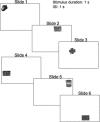Semantic elaboration in auditory and visual spatial memory
- PMID: 21833283
- PMCID: PMC3153833
- DOI: 10.3389/fpsyg.2010.00228
Semantic elaboration in auditory and visual spatial memory
Abstract
The aim of this study was to investigate the hypothesis that semantic information facilitates auditory and visual spatial learning and memory. An auditory spatial task was administered, whereby healthy participants were placed in the center of a semi-circle that contained an array of speakers where the locations of nameable and non-nameable sounds were learned. In the visual spatial task, locations of pictures of abstract art intermixed with nameable objects were learned by presenting these items in specific locations on a computer screen. Participants took part in both the auditory and visual spatial tasks, which were counterbalanced for order and were learned at the same rate. Results showed that learning and memory for the spatial locations of nameable sounds and pictures was significantly better than for non-nameable stimuli. Interestingly, there was a cross-modal learning effect such that the auditory task facilitated learning of the visual task and vice versa. In conclusion, our results support the hypotheses that the semantic representation of items, as well as the presentation of items in different modalities, facilitate spatial learning and memory.
Keywords: audition; cognitive map; hippocampus; spatial memory; vision.
Figures




References
-
- Anderson J. R., Reder L. M. (1979). “An elaborative processing explanation of depth of processing,” in Levels of Processing in Human Memory, eds Cermak L. S., Craik F. I. M. (Hillsdale, NJ: Lawrence Erlbaum Associates; ), 385–395 - PubMed
-
- Barnfield A. M. (1999). Development of sex differences in spatial memory. Percept. Mot. Skills 89, 339–350 - PubMed
-
- Belmore S. M. (1981). Imagery and semantic elaboration in hypermnesia for words. J. Exp. Psychol. Hum. Learn. Mem. 7, 191–203
LinkOut - more resources
Full Text Sources

